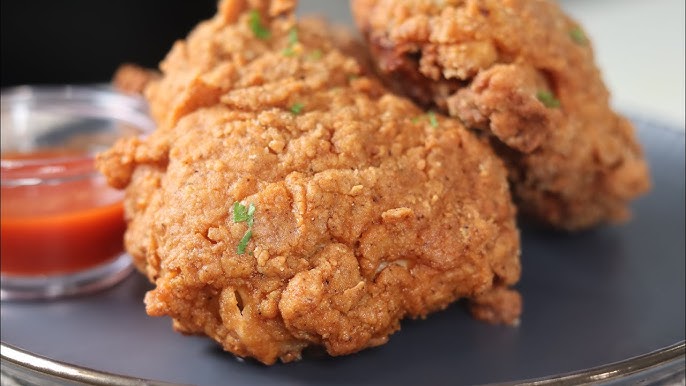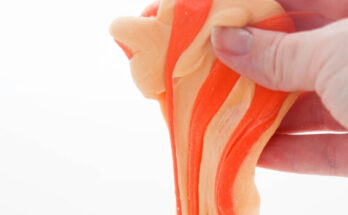Buttermilk Fried Chicken Recipe: Craving that crispy, juicy Southern-style fried chicken that makes your taste buds dance? Welcome to your ultimate guide to buttermilk fried chicken—the kind that’s perfectly golden on the outside and melt-in-your-mouth tender on the inside. There’s a reason why this comfort food classic has become a staple in kitchens around the world. Whether it’s your first time or your hundredth, this guide walks you through every crispy, juicy detail so you can make restaurant-quality chicken right at home.
What’s the secret? Buttermilk. It’s more than just an ingredient—it’s the magic potion that takes fried chicken from good to unforgettable. From prepping the poultry to perfecting the breading, let’s dive into everything you need to know to master this mouthwatering masterpiece.
Ingredients You’ll Need
Main Ingredients List
To make the most irresistible buttermilk fried chicken, you’ll need:
- Chicken: 2-3 lbs of chicken pieces (drumsticks, thighs, wings, or breasts—your call)
- Buttermilk: 2 cups for marinating
- All-purpose flour: 2 cups for dredging
- Eggs: 2 large eggs, beaten
- Salt: 1 tablespoon
- Black pepper: 2 teaspoons
- Garlic powder: 1 teaspoon
- Onion powder: 1 teaspoon
- Paprika: 1 teaspoon
- Cayenne pepper: ½ teaspoon (optional for heat)
- Oil: For frying (peanut, vegetable, or canola oil)
Optional Add-ins for Extra Flavor
Want to kick things up a notch? Try adding:
- A splash of hot sauce to your buttermilk marinade
- A teaspoon of dried herbs (thyme, oregano) to the flour mix
- Cornstarch in the flour mix for extra crunch
These extras can add a unique twist to your fried chicken while still keeping the classic flavors intact.
Why Use Buttermilk for Fried Chicken?
The Science Behind Buttermilk
Buttermilk is more than just a tradition in Southern cooking—it plays a vital role in the texture and flavor of fried chicken. The acidity in buttermilk helps to tenderize the chicken by breaking down the protein in the meat. This results in a juicy interior that stays moist even after frying.
Benefits of Buttermilk Marination
Marinating chicken in buttermilk doesn’t just tenderize—it infuses flavor deep into the meat. The lactic acid also creates a sticky surface that helps the seasoned flour adhere better during dredging, ensuring that every bite is evenly coated and crispy. If you’ve ever had fried chicken that tastes bland or dry, chances are they skipped this step. Trust us, it’s worth the extra time.
Step-by-Step Guide to Making Buttermilk Fried Chicken
Step 1: Preparing the Chicken
Start by washing and patting dry your chicken pieces. This helps the marinade stick better and prevents the oil from splattering too much when frying. If you’re using large breasts or thighs, consider cutting them in half so they cook evenly.
Step 2: Marinating in Buttermilk
Place your chicken in a large bowl or ziplock bag. Pour the buttermilk over it, ensuring every piece is fully submerged. Add a bit of salt, pepper, and hot sauce (if you like a little heat). Cover and refrigerate for at least 4 hours—overnight is even better. This is the key to maximum juiciness and flavor.
Step 3: Preparing the Breading
In a large bowl, mix the flour with garlic powder, onion powder, paprika, salt, black pepper, and cayenne. In a separate bowl, beat the eggs. If you want that extra crunch, throw in a couple of tablespoons of cornstarch to the flour mixture.
Step 4: Dredging the Chicken
Take the chicken out of the marinade and let the excess drip off. Dip it into the flour mixture, then into the beaten egg, and then back into the flour again. This double-dredge creates a thick, crispy coating that’s incredibly satisfying.
Step 5: Frying the Chicken to Perfection
Heat oil in a deep fryer or heavy-bottomed pot to 350°F (175°C). Carefully place a few pieces of chicken into the hot oil—don’t overcrowd the pan. Fry for about 12-15 minutes, turning occasionally, until golden brown and cooked through. The internal temperature should reach 165°F (74°C). Let the chicken rest on a wire rack to drain excess oil while maintaining its crispiness.
Tips for the Crispiest Fried Chicken
Achieving that perfect crunch in fried chicken isn’t just about the recipe—it’s about mastering the technique. Here are some essential tips to ensure your buttermilk fried chicken turns out crispy every time.
Maintain the Right Oil Temperature
One of the most critical factors in frying chicken is maintaining the correct oil temperature. If the oil is too hot, the exterior will burn before the inside cooks; too cool, and the chicken will absorb excess oil, becoming greasy.
- Optimal Temperature: Keep the oil between 300°F and 350°F (149°C to 177°C). Use a deep-fry thermometer to monitor the temperature accurately.
- Avoid Overcrowding: Fry the chicken in batches to prevent the oil temperature from dropping too much. Overcrowding can lead to uneven cooking and soggy crusts.
- Preheat Properly: Ensure the oil reaches the desired temperature before adding the chicken. Adding chicken to oil that’s not hot enough can result in greasy, undercooked meat.
Double Dredging for Extra Crunch
Double dredging involves coating the chicken in flour, then an egg wash, and back into the flour. This technique creates a thicker, crunchier crust.
- First Dredge: After marinating, coat the chicken in seasoned flour.
- Egg Wash: Dip the floured chicken into a mixture of beaten eggs and a splash of water or milk.
- Second Dredge: Return the chicken to the flour mixture, pressing firmly to ensure the coating adheres well.
- Rest Before Frying: Let the coated chicken rest on a wire rack for 10-15 minutes before frying. This helps the crust set and reduces the likelihood of it falling off during cooking.
Use the Right Equipment
- Heavy-Bottomed Pan: A cast-iron skillet or Dutch oven retains heat well and provides even cooking.
- Wire Rack: After frying, place the chicken on a wire rack instead of paper towels. This prevents the bottom from becoming soggy.
- Tongs: Use tongs to turn the chicken gently, minimizing the risk of knocking off the crust.
By paying attention to these details, you’ll elevate your buttermilk fried chicken to new heights of crispy perfection.
Common Mistakes to Avoid
Even seasoned cooks can make errors when frying chicken. Here are some common pitfalls and how to avoid them:
1. Skipping the Brine
Brining adds flavor and moisture to the chicken. Skipping this step can result in bland, dry meat. A simple buttermilk brine not only tenderizes the chicken but also infuses it with flavor.
2. Not Seasoning the Flour
The flour coating should be well-seasoned to ensure a flavorful crust. Incorporate spices like paprika, garlic powder, onion powder, and cayenne pepper into the flour for a tasty coating.
3. Frying Cold Chicken
Allow the chicken to come to room temperature before frying. Cold chicken can lower the oil temperature, leading to uneven cooking and greasy results.
4. Overcrowding the Pan
Adding too many pieces at once can drop the oil temperature, resulting in soggy chicken. Fry in batches, giving each piece enough space to cook evenly.
5. Using the Wrong Oil
Choose oils with high smoke points, such as peanut, canola, or vegetable oil. Avoid oils like olive oil, which have lower smoke points and can impart unwanted flavors.
6. Not Letting the Crust Set
After dredging, let the chicken rest before frying. This allows the coating to adhere better, reducing the chance of it falling off during cooking.
7. Inconsistent Piece Sizes
Cut chicken pieces to similar sizes to ensure even cooking. Larger pieces may remain undercooked while smaller ones overcook.
By being mindful of these common mistakes, you can ensure your fried chicken turns out perfectly every time.
Serving Suggestions
Buttermilk fried chicken is a star on its own, but the right side dishes and accompaniments can elevate your meal to a whole new level. Whether you’re putting together a picnic, Sunday dinner, or a weeknight indulgence, here’s how to serve it like a pro.
Classic Southern Sides
- Mac and Cheese: Creamy, cheesy, and rich—this dish perfectly complements the crispiness of fried chicken.
- Coleslaw: A tangy, crunchy slaw provides a refreshing contrast to the rich chicken.
- Biscuits: Fluffy and buttery, biscuits are a staple in any fried chicken feast.
- Mashed Potatoes & Gravy: Comfort food at its finest, this duo brings hearty satisfaction to every bite.
- Corn on the Cob: Whether grilled or boiled, corn adds sweetness and texture to your plate.
Modern Twists
- Avocado Salad: Adds a creamy, health-conscious spin to balance the meal.
- Sweet Potato Fries: A slightly healthier and flavorful alternative to regular fries.
- Pickles or Pickled Vegetables: Cut through the richness with some acidity.
Ideal Beverages
- Sweet Iced Tea: The classic Southern drink.
- Lemonade: Tart and sweet to cleanse the palate.
- Light Beer or Cider: Adds a crisp refreshment to the meal.
Best Sauces and Dips
- Honey Mustard: Sweet, tangy, and just a little spicy.
- Ranch Dressing: Creamy and herby, always a winner.
- Hot Sauce: For those who like it fiery.
- Aioli or Garlic Mayo: Adds richness and depth of flavor.
Pairing your buttermilk fried chicken with the right sides and dips ensures that every bite is satisfying from start to finish. Customize your spread depending on the occasion—whether it’s backyard BBQ vibes or a sit-down comfort food experience.
Storing and Reheating Tips
Let’s be real—fried chicken leftovers are a beautiful thing, but only if you store and reheat them the right way. Otherwise, you might end up with a soggy, sad piece of meat. Here’s how to keep that crisp alive.
How to Store Fried Chicken Properly
- Cool It First: Let your fried chicken cool to room temperature before refrigerating.
- Use Paper Towels: Line an airtight container with paper towels to absorb excess grease.
- Refrigeration: Store in the fridge for up to 4 days. For longer storage, freeze it.
How to Reheat Without Losing the Crunch
Oven Method (Best Option):
- Preheat oven to 375°F (190°C).
- Place chicken on a wire rack over a baking sheet.
- Heat for 15-20 minutes until hot and crispy.
Air Fryer Method:
- Set to 375°F (190°C) and heat for 5-8 minutes.
- Flip halfway through for even crisping.
Avoid the Microwave: It’s quick, but it turns your crunchy coating into a soggy mess. Only use it in a pinch and expect texture loss.
Freezing Fried Chicken
- Wrap each piece in foil or plastic wrap.
- Place in a freezer bag or airtight container.
- Freeze for up to 3 months.
- Reheat directly from frozen in the oven at 375°F for 25-30 minutes.
With proper storage and reheating, your fried chicken can taste just as good the second time around.
Nutritional Information
Let’s break down the nutritional profile of buttermilk fried chicken. Keep in mind, these numbers are estimates and vary based on portion size, ingredients, and cooking methods.
| Nutrient | Amount per Serving (1 Piece) |
|---|---|
| Calories | 350-450 kcal |
| Protein | 25-30g |
| Carbohydrates | 15-20g |
| Fat | 20-30g |
| Saturated Fat | 4-6g |
| Cholesterol | 80-100mg |
| Sodium | 500-700mg |
How to Make It Healthier
- Use Skinless Chicken: Reduces fat and calories.
- Air Fry Instead of Deep Frying: Cuts down significantly on oil.
- Use Whole Wheat Flour or Gluten-Free Alternatives: Healthier dredging options.
- Pair With Veggie Sides: Balance your meal with fresh, fiber-rich vegetables.
Even though fried chicken isn’t exactly diet food, enjoying it in moderation with thoughtful choices can let you savor every bite guilt-free.
FAQs about Buttermilk Fried Chicken Recipe
1. Why use buttermilk for fried chicken?
Buttermilk helps tenderize the chicken while also locking in moisture. Its acidity breaks down protein, making each bite juicy on the inside and crispy on the outside. Plus, it helps the flour coating stick better!
2. How long should I marinate the chicken in buttermilk?
For the best flavor and texture, marinate your chicken in buttermilk for at least 4 hours, but overnight is ideal. The longer it soaks, the better the flavor infusion.
3. Can I use regular milk instead of buttermilk?
Technically yes, but it’s not the same. You can DIY your own buttermilk by adding 1 tablespoon of lemon juice or vinegar to 1 cup of milk. Let it sit for 10 minutes and voilà — a homemade substitute!
4. What oil is best for frying chicken?
Go for high smoke point oils like peanut oil, vegetable oil, or canola oil. These handle the heat well and won’t overpower the flavor of your seasoned chicken.
5. How do I know when the chicken is cooked?
Use a meat thermometer! Chicken is fully cooked at an internal temperature of 165°F (74°C). No thermometer? Cut into the thickest part — the juices should run clear, not pink.
6. How do I keep my fried chicken crispy?
Drain on a wire rack instead of paper towels. Also, don’t overcrowd the pan — it lowers the oil temp and makes the coating soggy. Hot oil, space, and a rack = crispy magic.
7. Can I air-fry or bake instead of deep-frying?
Yes! While nothing beats the deep-fried crunch, you can use an air fryer at 375°F for 25–30 minutes or bake at 400°F for 40–45 minutes. Lightly spray with oil for golden crispness.
8. How long does fried chicken last?
Refrigerated fried chicken stays good for 3–4 days. Reheat in the oven or air fryer for best results — avoid the microwave if you want to keep that crunch.
9. Can I freeze buttermilk fried chicken?
Yes! Let it cool completely, wrap it tightly, and freeze for up to 3 months. Reheat straight from frozen in an oven to revive that crispy skin.
Conclusion
There you have it—a foolproof guide to crafting the crispiest, juiciest, most flavor-packed buttermilk fried chicken you’ll ever make. From the tangy marinade that tenderizes and flavors the meat to the double-dredged, golden-brown crust that crunches with every bite, this recipe is more than just food—it’s comfort, tradition, and a little bit of Southern magic on a plate.
Perfect for a weeknight dinner, a special occasion, or anytime you crave something indulgent, this buttermilk fried chicken recipe is one you’ll come back to again and again. So grab that buttermilk, heat up your oil, and let’s get frying!



